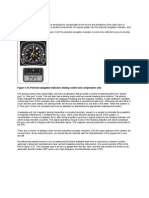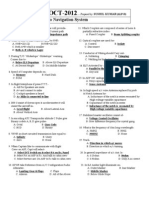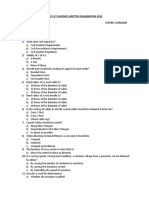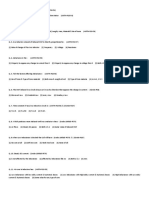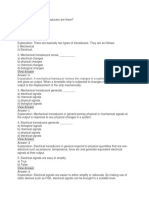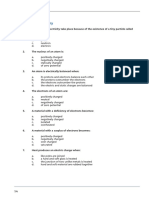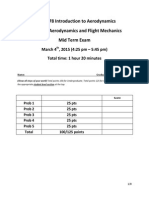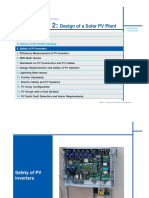Class Test 2 Question Paper
Uploaded by
brahma2deen2chaudharClass Test 2 Question Paper
Uploaded by
brahma2deen2chaudharINDIAN INSTITUTE OF TECHNOLOGY
Department of Electrical Engineering
Class Test-2
Date: 08-04-2021 Time: 45 minutes Sub. Name: Electrical Machines (EE21002)
Marks: 20
Q1. A 110V, 50 Hz, 4 pole capacitor start motor has the following constant in ohms.
R1m=2.02, X1m=2.79, R2=4.12, X2=2.12, Xm=66.8
Assume that core, friction and windage losses are zero.
Consider that it is running at a slip of 0.05, with the starting winding (auxiliary winding) open.
(i) Determine the ratio of the backward flux wave to the forward flux wave.
(ii) Determine the electromagnetic torque produced.
(iii) If the forward and backward flux waves are represented by space phasors, draw a
diagram showing the components and the resultant for ωt=450, zero time being chosen
as the instant when the forward and backward flux waves are in phase.
Marks: 5+2+1.5*2=10
Q2. (a) Show the winding connections of the following three phase transformers indicated by the
vector group (i) Dy1. Use dot and cross conventions to mark similar polarity of primary and
secondary coils. The input terminal are to be denoted as [A, B, C] and output terminals are to be
denoted as (a, b, c]. Consider that the phase sequence of the three phase supply is A-B-C. Here:
D: Delta; Y: Star; Capital Letter: Primary; Small Letter: Secondary.
Marks: 2
(b) Consider that the 3-phase transformer of vector group Yd11 is constructed by connecting a
bank of three single phase transformers each of which has a turns ratio of 10:1. The high voltage
terminals are marked as A, B, C and the low voltage terminals are marked as a, b, c. If the high
̅̅̅̅̅
voltage side line to line voltage 𝑉 0
𝐴𝐵 is represented by a phasor 22000∠0 V then what will the
phasor representation of the line to line voltage. ̅̅̅̅
𝑉𝑎𝑏 at the low voltage side be? Assume no-load
condition. Assume phase sequence as A-B-C.
Marks: 2
(c) A three phase Delta-Star transformer is rated at 5000 kVA, 2200 V:22000 V (both line to line),
50 Hz. Its impedance is 0.02+j0.09 per unit on its base. It is connected directly to a 2200 V (line
to line) 4000 kVA synchronous generator which can be represented as a voltage source in series
with a reactance of j1.4 per unit on the generator base. A three phase transmission line (or feeder)
of reactance j6 Ω/phase connects the transformer high voltage side to the load terminals. The
voltage at the generator terminals is 2200 V (line to line) and the generator output power is 2500
kW at rated current (lagging). Calculate (i) the voltage at the load terminals and (ii) the generator
internal voltage behind its reactance.
Marks: 3+3=6
You might also like
- CAAS 28jan2013 M3 Electrical Fundamentals BKNo ratings yetCAAS 28jan2013 M3 Electrical Fundamentals BK3 pages
- 1039.5Kwp PV Solar Solar System (PVS) 250Kw / 500Kwh Battery Energy Storage System (Bess)No ratings yet1039.5Kwp PV Solar Solar System (PVS) 250Kw / 500Kwh Battery Energy Storage System (Bess)1 page
- AER 504 Aerodynamics: Ryerson University Department of Aerospace EngineeringNo ratings yetAER 504 Aerodynamics: Ryerson University Department of Aerospace Engineering8 pages
- Procedure For IEEE 1584 Based Arc Flash CalculationsNo ratings yetProcedure For IEEE 1584 Based Arc Flash Calculations6 pages
- Service Manual For Frequency Control System: English 19.12.2007100% (1)Service Manual For Frequency Control System: English 19.12.200746 pages
- Volumes and Surface Area Aptitude QuestionsNo ratings yetVolumes and Surface Area Aptitude Questions11 pages
- OP-AMP (Integrator, Differentiator, Comparator Unity Follower)No ratings yetOP-AMP (Integrator, Differentiator, Comparator Unity Follower)9 pages
- Session Question From 2017 T0 2018 Module 04 B1No ratings yetSession Question From 2017 T0 2018 Module 04 B139 pages
- Current & Hysteresis Losses (4) Same Value For Any Type of CoreNo ratings yetCurrent & Hysteresis Losses (4) Same Value For Any Type of Core38 pages
- Electrics and Electricals Oxford QuestionsNo ratings yetElectrics and Electricals Oxford Questions83 pages
- Direct Reading Compass System: A. Aclinal Line (NP-81)100% (1)Direct Reading Compass System: A. Aclinal Line (NP-81)3 pages
- Lecture 5 Airfoils Nomenclature NACA SeriesNo ratings yetLecture 5 Airfoils Nomenclature NACA Series38 pages
- Questions For Asi Dvor: B) 108 To 118 MHZ With 50 KHZ Channel SpacingNo ratings yetQuestions For Asi Dvor: B) 108 To 118 MHZ With 50 KHZ Channel Spacing3 pages
- LectureNote - 04-Ch4 - Oblique Shock and Expansion Waves - Part1No ratings yetLectureNote - 04-Ch4 - Oblique Shock and Expansion Waves - Part127 pages
- Semester - Ii Electrical Fundamental - I: Avionics (B2)No ratings yetSemester - Ii Electrical Fundamental - I: Avionics (B2)40 pages
- Modeling & Analysis Lab Manual - 15ael77: Vii SemesterNo ratings yetModeling & Analysis Lab Manual - 15ael77: Vii Semester27 pages
- I I T, K K: IM31002/61004: Quality Engineering Course Syllabus - Spring 2022No ratings yetI I T, K K: IM31002/61004: Quality Engineering Course Syllabus - Spring 20222 pages
- Industrial Control Systems: Concepts, Components, and Architectures100% (1)Industrial Control Systems: Concepts, Components, and Architectures12 pages
- Department of Electrical Engineering IIT KharagpurNo ratings yetDepartment of Electrical Engineering IIT Kharagpur2 pages
- Answer All The Questions: From-To Data For The Parts Processed by The Machines Are Shown in The Table BelowNo ratings yetAnswer All The Questions: From-To Data For The Parts Processed by The Machines Are Shown in The Table Below2 pages
- Submission Deadlines: Part-1 (30 Min: 8 To 830 AM)No ratings yetSubmission Deadlines: Part-1 (30 Min: 8 To 830 AM)1 page
- Electrical Machines EE21002: Outline of The CourseNo ratings yetElectrical Machines EE21002: Outline of The Course3 pages
- 100+ Quotes For An Occasion: 50 Inspirational Quotes For When Your Mood Could Use A BoostNo ratings yet100+ Quotes For An Occasion: 50 Inspirational Quotes For When Your Mood Could Use A Boost2 pages
- A Synopsis ON: "Quality of Electric Power"No ratings yetA Synopsis ON: "Quality of Electric Power"5 pages
- Construction, working principle and applications of DC Machines 4-1No ratings yetConstruction, working principle and applications of DC Machines 4-135 pages
- 2018MicrogridControlandProtectionStateoftheArtAComprehensiveOverviewNo ratings yet2018MicrogridControlandProtectionStateoftheArtAComprehensiveOverview18 pages
- Dimensions and Terminal (Unit: MM (Inches) )No ratings yetDimensions and Terminal (Unit: MM (Inches) )2 pages
- BPC Midterm Exam On Transformer & Motor Rewindings 2019No ratings yetBPC Midterm Exam On Transformer & Motor Rewindings 20195 pages
- IEC 61000-4-4: Electrical Fast Transient/Burst Immunity TestNo ratings yetIEC 61000-4-4: Electrical Fast Transient/Burst Immunity Test5 pages
- 2.3 DEWA Training - Design of A Solar PV System - Part 2100% (1)2.3 DEWA Training - Design of A Solar PV System - Part 242 pages
- User'S Manual: Microflex E150 Servo DriveNo ratings yetUser'S Manual: Microflex E150 Servo Drive182 pages




